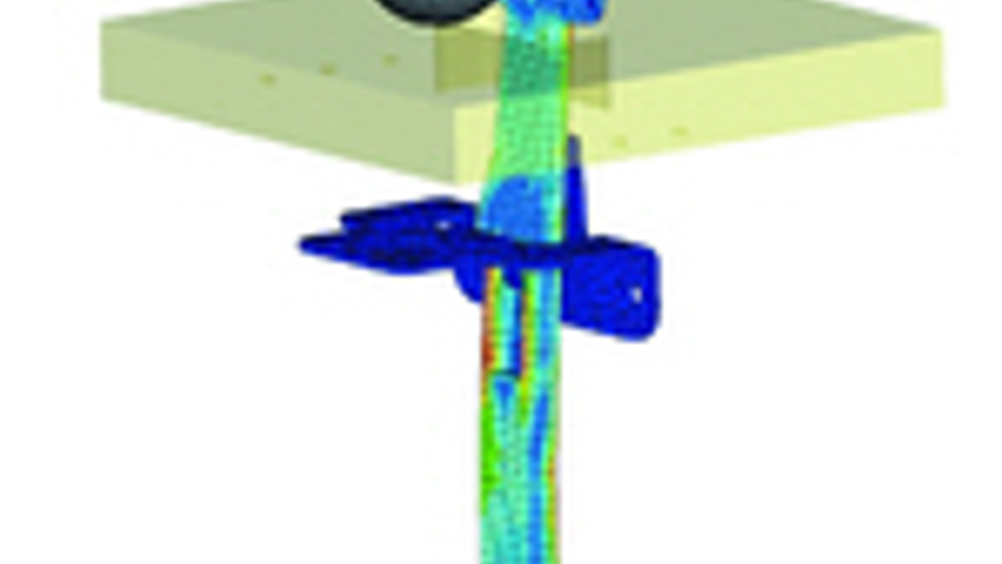Pinball wizards redesign using FEA
Using 3D modelling, FEA and motion analysis software, a manufacturer of pinball machines has solved a key mechanical assembly problem. Dean Palmer reports

Using 3D modelling, FEA and motion analysis software, a manufacturer of pinball machines has solved a key mechanical assembly problem. Dean Palmer reports
Stern Pinball based in the US is the only manufacturer of coin-operated pinball machines in the world. Due to acquisitions and a thirst for technical innovation, the company now enjoys an exclusive market position. Pinball games today are designed using sophisticated computer simulation software, including Algor's finite element analysis (FEA) software.
Using 3D modelling tools to create many of the typical game parts, the firm employs four mechanical engineers and numerous designers to create state-of-the-art pinball machines that include English, Spanish, French, Italian and German voice and visual language response.
Each new game takes about one year to design. Stern employs 63 core staff boosted by a further 200 temporary employees who produce up to 55 new games per day. The designers challenge themselves, employing competition among design teams, to develop innovative, exciting new games such as its recent 'Grand Prix' pinball machine. The company recently used Algor FEA software to analyse a mechanical assembly that was failing during use in one of its games.
The design team ran into problems with the 'drop-target assembly', a mechanical assembly on the pinball playfield. The assembly consists of a plastic target that retracts beneath the playfield when struck by the solid metal pinball. The idea of the game element is to strike the target and then re-direct the ball up the ramp to score points. In the new game, the drop target was placed, without backing, in front of the ramp. When struck by the ball at near-maximum speeds, the testers found a high incidence of breakage in the target.
John Rotharmel, project engineer at Stern, designs most of the games' unique elements. Previously, the company exclusively used Cosmos Express to model such parts. But from his own experience of using FEA software, Rotharmel knew that Algor FEA would be necessary for the dynamic analysis of the moving target. He therefore purchased a copy of the software to evaluate the drop-target design and showed his design to Stern's president, Gary Stern.
Recognising the value of Algor analysis, Stern asked Rotharmel to investigate the product more thoroughly. Convinced that Mechanical Event Simulation (MES) software was necessary, the company bought Algor 'Professional MES', which combines large-scale motion and stress analysis and includes linear and non-linear material models.
The combination of motion and stress analysis considering full inertial effects allows engineers to see motion and the results, such as impact, buckling and permanent deformation. Having never used MES before, Rotharmel said he was pleasantly surprised at how easy it was. "It was simply a matter of knowing what parameters to use to set up the model, how to make sure you choose the right components for the assembly, how to test the proper criteria using comparative analysis, changing the ball velocity and so forth." After experimenting, he said he quickly began to model and analyse the action of the ball against the target.
Around the same time, the company also purchased a high-speed video camera and Rotharmel recorded the action of the ball as it struck the drop target. Engineers at the company then compared the high-speed video with the analysis results.
After several iterations, Rotharmel said he realised that he had successfully modelled the event quite closely: "The event in Algor and the real-world event were remarkably similar," he explained. The company was able to confirm that the drop target needed to be strengthened before use in one of its recent games.
Using the results of the analysis, the part was entirely re-designed. In fact, the new target assembly barely resembled the previous part. The hardware was changed, and while made of the same material, the target itself was flattened and simplified. Using Algor, the firm's engineers also cut the cost of designing and engineering the part. "We are the only game in town, but we never want to be complacent about our product," stated Rotharmel. "Algor helped us keep our commitment to quality, innovative and robust games that challenge game users but won't break during use."
Pointers
* After FEA and motion simulation analysis, engineers at Stern totally re-designed the mechanical target assembly
* The software enabled engineers to cut the cost of designing and engineering the part










